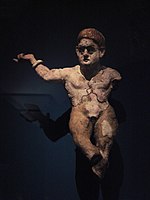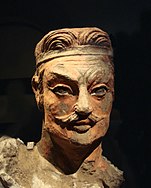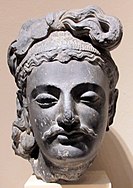Khalchayan
Khalchayan(alsoKhaltchaïan) is an archaeological site, thought to be a small palace or a reception hall, located near the modern town ofDenovinSurxondaryo Regionof southernUzbekistan.It is located in the valley of theSurkhan Darya,a northern tributary of theOxus(modernAmu Darya).
Terracotta statues[edit]
The site is usually attributed to the earlyKushans,or their ancestors theYuezhi/Tocharians.[6]It was excavated byGalina Pugachenkovabetween 1959 and 1963. The interior walls are decorated with clay sculptures and paintings dated to the mid-1st century BCE, but they are thought to represent events as early as the 2nd century BCE.[7]Various panels depict scenes of Kushan life: battles, feasts, portraits of rulers.
Some of the Khalchayan sculptural scenes are thought to depict the Kushans fighting against aSakatribe.[8]The Yuezhis are shown with a majestic demeanour, whereas the Sakas are typically represented with side-wiskers in more or less grotesque attitudes.[8]
Portrait of a Parthian king[edit]
The bust of a Parthian king was discovered among the sculptures at Khalchayan, and the time period and resemblance from numismatics suggest that this may representVardanes Ias he sought refuge, and possibly an alliance, inBactriaat the Yuezhi court.[9]Tacitusrelated that Vardanes "took refuge among the Bactrians", after his failure at the siege ofSeleuciacirca 35 CE.[9]These events might give aterminus post quemof around 45-47 CE for the Khalchayan portrait of the Parthian king, a period when the contemporary Kushan ruler may have beenKujula Kadphises.[9]
-
Yuezhi Prince from Khalchayan. At his feet, the trophy of aSakacataphractarmour with neck-guard. 1st century BCE.Museum of Arts of Uzbekistan,nb 40.[10][11]
-
The Prince displaysartificial cranial deformation.[12]
-
Another terracotta statue from Khalchayan, 1st century BCE-1st century CE.Termez Archaeological Museum.
-
Saka soldier, Kalchayan
-
Kalchayan, King on a throne
-
Kalchayan portrait.Museum of Arts of Uzbekistan
-
Portrait of a Parthian king, possiblyVardanes I.[9]
-
Khalchayan cherub.
Influences[edit]

According to Benjamin Rowland, the art of Kalchayan of the end of the 2nd century BCE is ultimately derived fromHellenistic art,and possibly from the art of the cities ofAi-KhanoumandNysa,but it also has similarities with the laterArt of Gandharaand may even have been at the origin of its development.[12]
Rowland particularly draws attention to the similarity of the ethnic types represented at Khalchayan and in the art of Gandhara, and also in the style of portraiture itself.[12]For example, Rowland find a great proximity betweenthe famous head of a Yuezhi princefrom Khalchayan, and the head of GandharanBodhisattvas,giving the example of the Gandharan head of a Bodhisattva in thePhiladelphia Museum of Art.[12]The similarity of the Gandhara Bodhisattva with the portrait of the Kushan rulerHeraiosis also striking.[12]According to Rowland the Bactrian art of Khalchayan thus survived for several centuries through its influence in the art of Gandhara, thanks to the patronage of theKushans.[12]
According to Chinese researcher Duan Qingbo, the style and construction techniques of the Khalchayan statues closely resembles those of the earlier Terracotta Army, which may suggest some form of artistic influence.[13]
References[edit]
- ^KHALCHAYAN – Encyclopaedia Iranica.p. Figure 1.
- ^"View in real colors".
- ^Abdullaev, Kazim (2007)."Nomad Migration in Central Asia (in After Alexander: Central Asia before Islam)".Proceedings of the British Academy.133:87–98.
- ^Greek Art in Central Asia, Afghan – Encyclopaedia Iranica.
- ^Also a Saka according to this source:[1]
- ^Betts, Alison; Vicziany, Marika; Jia, Peter Weiming; Castro, Angelo Andrea Di (19 December 2019).The Cultures of Ancient Xinjiang, Western China: Crossroads of the Silk Roads.Archaeopress Publishing Ltd. p. 104.ISBN978-1-78969-407-9.
- ^"It is possible to attribute the Khalchayan reliefs to the first century BC archaeologically, but the historical events reflected in them belong to an earlier period, i.e. to around the middle of the second century BC."Abdullaev, Kazim (2007)."Nomad Migration in Central Asia (in After Alexander: Central Asia before Islam)".Proceedings of the British Academy.133:91.
- ^ab"The knights in chain-mail armour have analogies in the Khalchayan reliefs depicting a battle of the Yuezhi against a Saka tribe (probably the Sakaraules). Apart from the chain-mail armour worn by the heavy cavalry of the enemies of the Yuezhi, the other characteristic sign of these warriors is long side-whiskers (...) We think it is possible to identify all these grotesque personages with long side-whiskers as enemies of the Yuezhi and relate them to the Sakaraules (...) Indeed these expressive figures with side-whiskers differ greatly from the tranquil and majestic faces and poses of the Yuezhi depictions."Abdullaev, Kazim (2007)."Nomad Migration in Central Asia (in After Alexander: Central Asia before Islam)".Proceedings of the British Academy.133:89.
- ^abcdGrenet, Frantz (2022).Splendeurs des oasis d'Ouzbékistan.Paris: Louvre Editions. p. 58.ISBN978-8412527858.
- ^Frantz, Grenet (2022).Splendeurs des oasis d'Ouzbékistan.Paris: Louvre Editions. p. 56.ISBN978-8412527858.
- ^KHALCHAYAN – Encyclopaedia Iranica.p. Figure 1.
- ^abcdefgRowland, Benjamin (1971). "Graeco-Bactrian Art and Gandhāra: Khalchayan and the Gandhāra Bodhisattvas".Archives of Asian Art.25:29–35.ISSN0066-6637.JSTOR20111029.
- ^Qingbo, Duan (2022)."Sino-Western Cultural Exchange as Seen through the Archaeology of the First Emperor's Necropolis".Journal of Chinese History trung quốc lịch sử học khan.7:21–72.doi:10.1017/jch.2022.25.ISSN2059-1632.S2CID251690411.
The only thing that closely matches the artistic style of the imperial Qin terracotta warriors is the head of a painted pottery figure unearthed in Uzbekistan (...) The way of assembling the head and body for this Kushan figure of a warrior (possibly Saka) was the same as that employed for the Qin terracotta warriors, in that they were fabricated separately, and then the head was inserted into the trunk of the figure.
Sources[edit]
- "Les Saces", Iaroslav Lebedynsky
Further reading[edit]
- G. A. Pugachenkova.."The Sculpture of Khalchayan".Moscow, 1970.
- G. A. Pugachenkova."Khalchayan".Tashkent, 1966.
External links[edit]
- "A Comparison of Images of Kushans from Coins and Sculpture",with images from Pugachenkova (1970)The Sculpture of Khalchayan.{dead link}
- "Khalchayan",Encyclopædia Iranica.





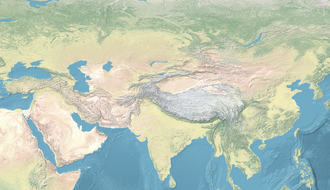



![Yuezhi Prince from Khalchayan. At his feet, the trophy of a Saka cataphract armour with neck-guard. 1st century BCE. Museum of Arts of Uzbekistan, nb 40.[10][11]](https://upload.wikimedia.org/wikipedia/commons/thumb/c/c2/Kalchayan_Prince_warrior_%28full%29.jpg/122px-Kalchayan_Prince_warrior_%28full%29.jpg)
![The Prince displays artificial cranial deformation.[12]](https://upload.wikimedia.org/wikipedia/commons/thumb/2/22/Kalchayan_Prince_profile.jpg/161px-Kalchayan_Prince_profile.jpg)

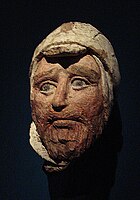
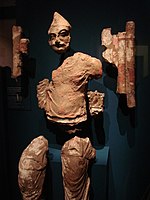

![Portrait of a Parthian king, possibly Vardanes I.[9]](https://upload.wikimedia.org/wikipedia/commons/thumb/9/94/Khalchayan_Parthian_king.jpg/164px-Khalchayan_Parthian_king.jpg)
